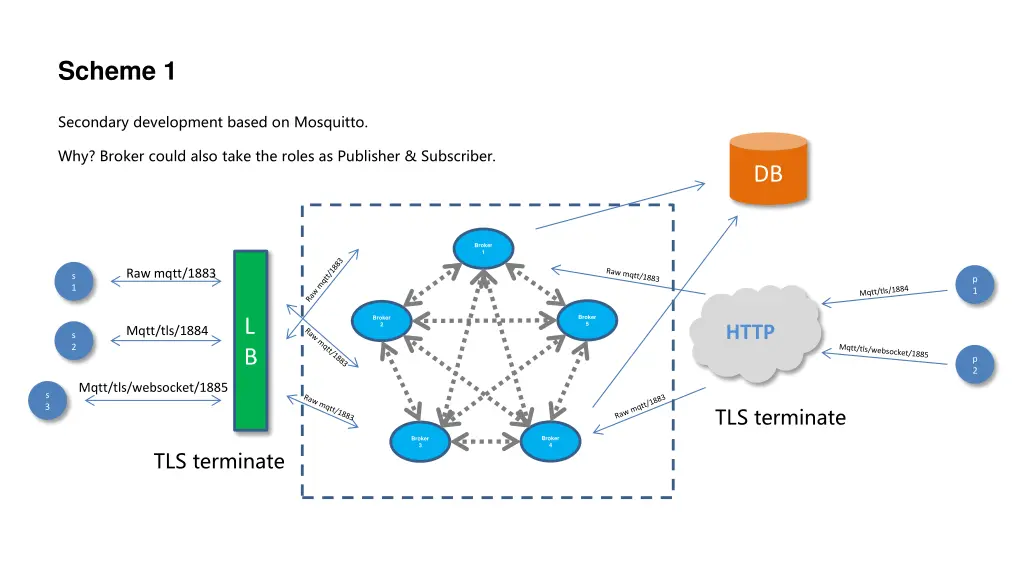
Secondary Development with Mosquitto - Bridge and Subscribe Patterns
Explore a secondary development based on Mosquitto that allows brokers to take on roles as publishers and subscribers. Learn about the implementation, auto-reconnect features, fault detection mechanisms, and more in this detailed scheme.
Download Presentation

Please find below an Image/Link to download the presentation.
The content on the website is provided AS IS for your information and personal use only. It may not be sold, licensed, or shared on other websites without obtaining consent from the author. If you encounter any issues during the download, it is possible that the publisher has removed the file from their server.
You are allowed to download the files provided on this website for personal or commercial use, subject to the condition that they are used lawfully. All files are the property of their respective owners.
The content on the website is provided AS IS for your information and personal use only. It may not be sold, licensed, or shared on other websites without obtaining consent from the author.
E N D
Presentation Transcript
Scheme 1 Secondary development based on Mosquitto. Why? Broker could also take the roles as Publisher & Subscriber. DB Broker 1 Raw mqtt/1883 s 1 p 1 Broker 5 Broker 2 L B HTTP Mqtt/tls/1884 s 2 p 2 Mqtt/tls/websocket/1885 s 3 TLS terminate Broker 4 Broker 3 TLS terminate
Bridge pattern Publish TCP connection Topic = /A/B/C Bridge 1.Publisher /A/B/D MUST IN on this conn.!!! 2.Subscriber Broker 4 Broker 1 /A/B/D is OUT or BOTH on this Connection. 3.Subscriber Broker 1-1 Topic = /A/B/D /A/B/C is IN or not configured on this Connection. 4.Publisher /A/B/C is OUT or BOTH on this Connection. Round Robin / Standby Broker 3 Broker 2 5.Subscriber System topic This is the bridge design patter, which is a centralized cluster and the bridge take too much traffic.
Sub / unsub bak1 Broadcast SUB Publish TCP connection Broker 1 1.Publisher 2.Subscriber Broker 5 Broker 2 Step2. SubRelation 3.Subscriber 4.Publisher Broker 4 Broker 3 5.Subscriber Step1. UNSUBSCRIBE Step2. unSubRelation Broadcast the SUBSCRIBE message to other node in the cluster. System topic
Implementation Messages Context is_node Context is_peer Context is_peer TCP connection 1.Publisher local remote 2.Subscriber 1.Subscriber CONNECT: this is a node, version |= MOSQ_NODE_MEET CONNACK: this is a peer SUBSCRIBE: for all topics PUBLISH: from node SUBACK 2.Subscriber PINGREQ: every keepalive seconds PINGRESP SUBSCRIBE: broadcast for only client SUBSCRIBE SUBACK PUBLISH: only fwd to client 3.Publisher Traffic cycle avoidance: For PUB msgs, send to only clients if these msgs come from other nodes. For SUB/UNSUB msgs, do not broadcast if these msgs come from other nodes. PUBACK PUBLISH: to whoever subscribed PUBACK
Implementation Auto Reconnect Send TCP SYN to other nodes which configured inside mosquitto.conf, 2s later check the TCP connection, and send CONNECT message(version|=0x40) once TCP connect success, otherwise retransmit SYN 5s later. Fault Detection For remote process EXIT/CRASH, remote Kernel would close the socket, For remote Kernel CRASH or network issue, check PINGRESP 2s later after the PINGREQ sent. Subscribe Relationship Recovery Save all topics which comes from all clients, send to all other nodes after each time CONNECT success. Reload CFG Try to CONNECT with the new nodes and remove the connection with the nodes which no longer exists in the mosquitto.conf
Implementation Timer optimization Use a min heap(as libevent) to save all clients and nodes context which connect with local node, the key is last_msg_in + keepalive. Insert the context to the min heap while accept a new socket, update the context in the socket once receive a non-DISCONNECT message, and erase the context from the heap once receive DISCONNECT message. For local ==> remote nodes contexts, simply roll poling for the PINGREQ & PINGRESP timer. Use epoll_wait instead of poll, and the timeout is MIN(next_timer, 2s). TOPICs save Store the topic payload inside DB, use reference counter, delete the TOPIC while this TOPIC no longer subscribed by any clients. Deployment Deploy one instance on one core in SMP machine, listen on different ports.
EMQ EMQ which also called emqttd, is an open source MQTT broker which is cluster design. Each node of EMQ cluster saves the global Topic Trie and Route Map. Subscribe relationship: Clients: Nodes: TOPICs: client1 node1 t/+/x, t/+/y client2 node2 t/# client3 node3 t/+/x, t/a ------------------------------------- | t | | / \ | + # | | / \ | x y | ------------------------------------- | t/+/x -> node1, node3 | | t/+/y -> node1 | | t/# -> node2 | | t/a -> node3 | ------------------------------------- Subscribe and Msg dispath Topic Trie | title: Message Route and Deliver client1->node1: Publish[t/a] node1-->node2: Route[t/#] node1-->node3: Route[t/a] node2-->client2: Deliver[t/#] node3-->client3: Deliver[t/a] | Route Map
Other schemes There re also other schemes, like Redis 3.0 PUB/SUB design and other Message Queues, but which either have heavy traffic(Redis) or have complicate consistence maintain, like gossip/raft/paxos.
Sub / unsub bak1 Scheme 2 Broadcast PUBs Publish TCP connection Broker 1 1.Publisher 2.Subscriber Broker 5 Broker 2 3.Subscriber HASH(/A/B/D) == 4321 4.Publisher Broker 4 Broker 3 5.Subscriber This is the implement of Redis. System topic
Logic connection Sub / unsub bak1 Scheme 3 DHT Publish TCP connection HASH(/A/B/C) == 15678 Broker1 (0~ 3276) 1.Publisher 2.Subscriber Broker5 (13105~ 16383) Broker2 (3277~ 6552) Step2. UNSUBSCRIBE 3.Subscriber HASH(/A/B/D) == 4321 4.Publisher Broker4 (9829~ 13104) Broker3 (6553~ 9828) 5.Subscriber Most MQs pattern: All the PUB/SUBs send to the proper node. This is complicate for consistency maintain. System topic
